Euroacademia Conferences
 Europe Inside-Out: Europe and Europeanness Exposed to Plural Observers (9th Edition) April 24 - 25, 2020
Europe Inside-Out: Europe and Europeanness Exposed to Plural Observers (9th Edition) April 24 - 25, 2020 Identities and Identifications: Politicized Uses of Collective Identities (9th Edition) June 12 - 13, 2020
Identities and Identifications: Politicized Uses of Collective Identities (9th Edition) June 12 - 13, 2020 8th Forum of Critical Studies: Asking Big Questions Again January 24 - 25, 2020
8th Forum of Critical Studies: Asking Big Questions Again January 24 - 25, 2020 Re-Inventing Eastern Europe (7th Edition) December 13 - 14, 2019
Re-Inventing Eastern Europe (7th Edition) December 13 - 14, 2019 The European Union and the Politicization of Europe (8th Edition) October 25 - 26, 2019
The European Union and the Politicization of Europe (8th Edition) October 25 - 26, 2019 Identities and Identifications: Politicized Uses of Collective Identities (8th Edition) June 28 - 29, 2019
Identities and Identifications: Politicized Uses of Collective Identities (8th Edition) June 28 - 29, 2019 The European Union and the Politicization of Europe (7th Edition) January 25 - 26, 2019
The European Union and the Politicization of Europe (7th Edition) January 25 - 26, 2019 7th Forum of Critical Studies: Asking Big Questions Again November 23 - 24, 2018
7th Forum of Critical Studies: Asking Big Questions Again November 23 - 24, 2018 Europe Inside-Out: Europe and Europeanness Exposed to Plural Observers (8th Edition) September 28 - 30, 2018
Europe Inside-Out: Europe and Europeanness Exposed to Plural Observers (8th Edition) September 28 - 30, 2018 Identities and Identifications: Politicized Uses of Collective Identities (7th Edition) June 14 - 15, 2018
Identities and Identifications: Politicized Uses of Collective Identities (7th Edition) June 14 - 15, 2018
Depictions of America in Humboldt’s Work: The Art Dialogue
-
-

-
Presentation speakers
- Elisa Garrido, Consejo Superior de Investigaciones Científicas, Madrid, Spain
Abstract:
Examining the intersection between the Alexander von Humboldt’s work Vues des Cordillères, et monumens des peuples indigènes de l’Amérique (1810) and landscape painting of the nineteenth century, we can note his tremendous artistic legacy, since Humboldt assumed the landscape as the best way of representing Nature. After his travel to America, his publications greatly shaped the visual characterization of American tropical nature and its knowledge, but Humboldt makes picturesque scenes, a term frequently used for referring to the pictorial representation of the scenes of Nature very close to the new sensibility of European Romanticism, in which Humboldt was academically formed. Vues des Cordillères is a work from different contributions and disciplines, which creates a collective document of American space on the move, in a time when America and Europe were exchanging their world knowledge. This paper will explore the depiction of different cultures in one book, through the European imaginary.
-
Related Presentations


















